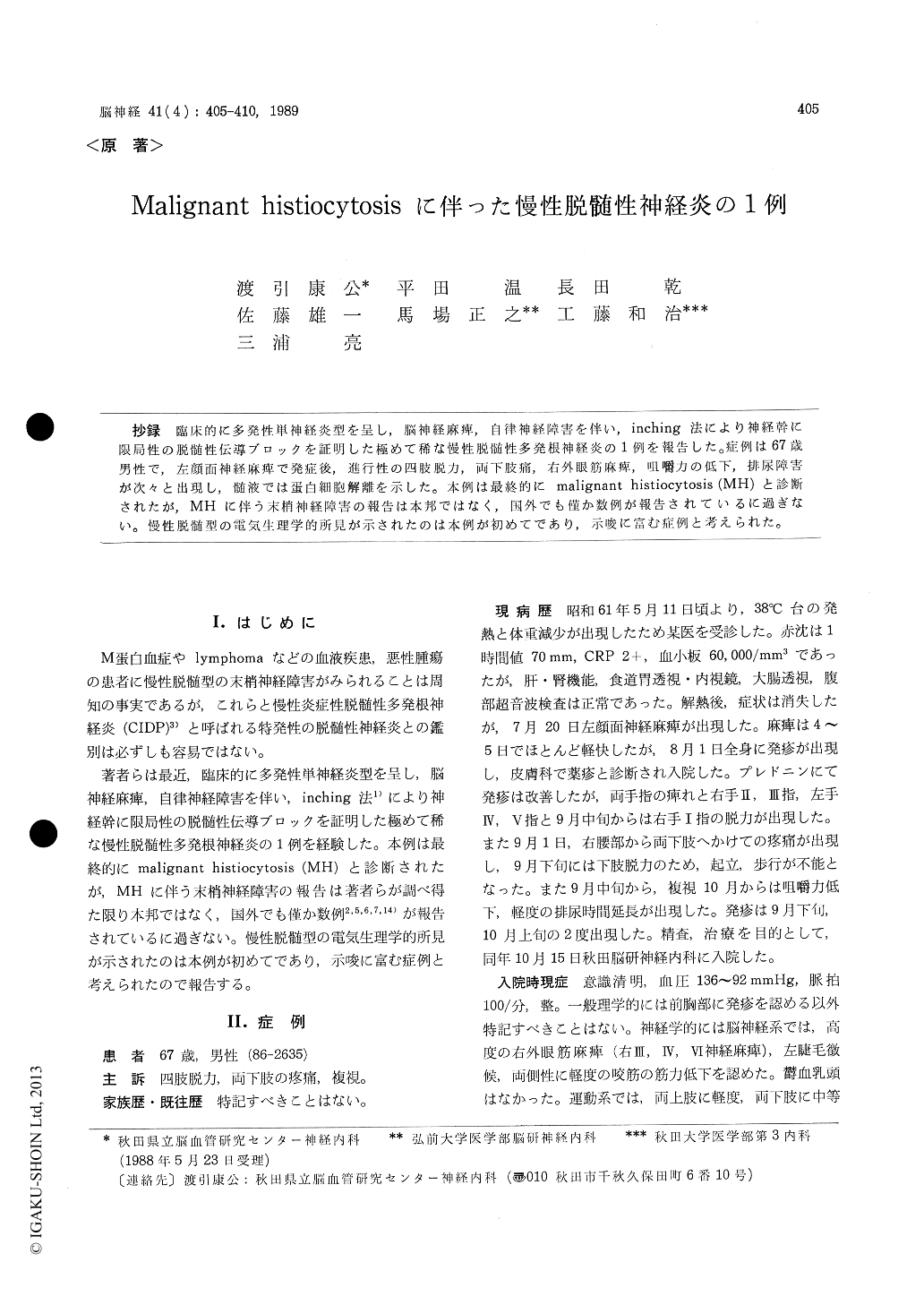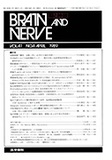Japanese
English
- 有料閲覧
- Abstract 文献概要
- 1ページ目 Look Inside
抄録 臨床的に多発性単神経炎型を呈し,脳神経麻痺,自律神経障害を伴い,inching法により神経幹に限局性の脱髄性伝導ブロックを証明した極めて稀な慢性脱髄性多発根神経炎の1例を報告した。症例は67歳男性で,左顔而神経麻痺で発症後,進行性の四肢脱力,両下肢痛,右外眼筋麻痺,咀嚼力の低下,排尿障害が次々と出現し,髄液では蛋白細胞解離を示した。本例は最終的にmalignant histiocytosis (MH)と診断されたが,MHに伴う末梢神経障害の報告は本邦ではなく,国外でも僅か数例が報告されているに過ぎない。慢性脱髄型の電気生理学的所見が示されたのは本例が初めてであり,示唆に富む症例と考えられた。
A case of malignant histiocytosis (MH) pre-senting with peripheral nerve involvement is des-cribed.
A 67-year-old man initially noted left facial weakness on July 20, 1986. The symptom was improved within a week, however, two weeks later he noticed numbness in his fingers and a burning pain in his legs, which was followed by double vision and progressive weakness in all four limbs. On examination, he was found to have total ophthalmoparesis of the right eye and a trace of the left facial palsy. There was severe weakness of the leg muscles, as well as mild weakness of the arms. This was accompanied by wasting of his limbs. All tendon reflexes were absent. Planter responses were flexor. Al-though cutaneous sensation was intact, vibratory sense was markedly impaired in the legs below the knees. The sphincter function was mildly disturbed. The sedimentation rate was 32 mm/hr. The hemoglobin was 11. 9 g/dl and the leukocyte count was 5, 700/mm3. The platelet count fell to 60, 000/mm3. Results of routine biochemical and radiological studies were unremarkable. The cere-brospinal fluid protein level was 129 mg/dl with a normal cell count. Motor nerve conduction study revealed marked reduction in amplitude of the compound muscle action potential, slow motor nerve conduction velocities and multifocal con-duction blocks along the nerve trunks (the left ulnar nerve in the forearm, the bilateral tibial nerve in the lower leg). F-wave was absent or elicitable with prolonged latency and with in-creased chrono-dispersion. Sensory nerve had nor-mal or nearly normal conduction. EMG sampling showed an impaired interference pattern during voluntary contraction and a few denervation po-tentials at rest.
He was treated with prednisolone and his ophthalmoparesis was partially improved without obvious improvement in weakness in four limbs. Shortly thereafter, his weakness worsened again and pancytopenia developed. Bone marrow aspira-tion was hypoplastic and disclosed erythrophago-cytic histiocytes and immature reticulum cells. The latter were large and irregular, and had abundant basophilic cytoplasm and primitive nuc-lei. These findings were believed to be consistent with a MH. The patient died of pulmonary bleed-ing about five months after the onset of his initial neurological symptoms. Permission for post-mortem examination was not given.
MH, also called histiocytic medullary reticulosis, is a relatively rare disease. The clinical features of MH include fever, wasting, generalized lym-phadenopathy, and hepatosolenomegaly, freauentivaccompanied by jaundice and pancytopenia. Al-though skin and central nervous system involve-ment has been described, relatively little attention has been directed toward the peripheral nerve involvement. The present case is the first Japanesecase of peripheral neuropathy associated with MH, in which electrophysiological evidence of conduc-tion block was confirmed.

Copyright © 1989, Igaku-Shoin Ltd. All rights reserved.


